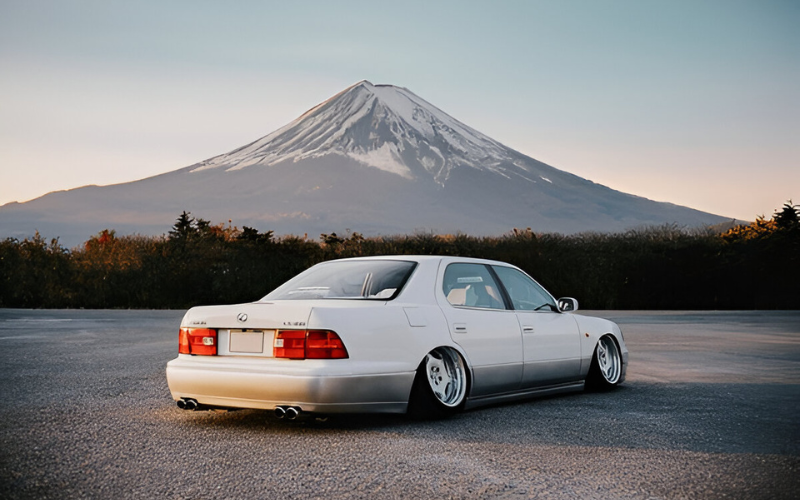Introduction
The Lexus LS400 Celsior has earned a special place in car culture because it blends quiet luxury, careful engineering, and long-term reliability. In 2025, it stands out as a car that still feels calm, solid, and modern enough for daily use, while also carrying the charm of a well‑built 1990s flagship.
A Brief History of the Lexus LS400 Celsior
The Launch of Lexus and the Birth of the Celsior
When Toyota set out to create a world‑class luxury brand in the late 1980s, the result was Lexus—and its first flagship was the LS400. In Japan, the same car wore a different badge and name: Toyota Celsior. The project focused on silence, smoothness, and quality. Engineers chased tiny details most drivers never notice, like the way doors close, the softness of the ride over rough roads, and the low wind noise at highway speeds. The LS400 debuted in North America, while the Celsior went on sale in Japan with similar hardware but local market options and trim differences.
From the start, the Lexus LS400 Celsior showed a new approach to luxury. It aimed to give owners a peaceful driving experience, easy controls, and dependability that reduced stress and cost over time. That mindset would later shape the way many people think about premium cars: not just about power or badges, but about the day‑to‑day comfort of living with the car.
Global Reception and Impact on the Luxury Market
The reception was strong. Reviewers praised the quiet cabin, the smooth V8, and the way the car felt “tight” even after many miles. Owners appreciated simple controls, clear instruments, and build quality that held up. Many luxury brands responded by improving their own refinement and reliability. In short, the Lexus LS400 Celsior nudged the market toward better quality and customer care, and it helped Lexus grow worldwide as a serious alternative to traditional European names.
Timeless Design and Engineering Excellence
Exterior Styling and Subtle Elegance
The shape of the LS400/Celsior is calm and balanced. There are no wild lines or distracting details. The design is clean, with straight body sides, a gently curved roof, and lights that fit the car’s simple style. Even today, the car does not look dated so much as dignified. That quiet look is part of its appeal: it’s a luxury sedan that does not shout. For many people in 2025, that understatement feels fresh in a world of bold grilles and sharp creases.
Aerodynamics also played a role. The smooth body helped reduce wind noise, which supported the car’s mission of calm travel. The panels fit tightly, the glass sits flush, and the hood and mirrors are shaped to move air cleanly around the car. Small choices like these add up to the hushed ride that fans of the Lexus LS400 Celsior love.
Interior Craftsmanship and Comfort
Inside, the LS400/Celsior is built for comfort and clarity. Seats are soft yet supportive. Controls are laid out where your hands expect them to be. The gauges and buttons are easy to read, and the steering wheel and pedals feel natural. Materials—leather, wood, switches, and carpets—were chosen to age well. Many examples still feel solid decades later, which is a big reason this model is a cult classic.
Sound insulation was another focus. Engineers layered materials in the doors, floor, and firewall to cut noise. The result is a cabin that stays calm on the highway, letting you talk in a normal voice even at speed. This peaceful driving environment remains a signature trait in 2025, especially compared with many older cars.
Performance, Reliability, and the 1UZ Engine
Driving Feel and Smoothness
Under the hood sits the 1UZ‑FE V8, known for its smooth character and refined sound. Power delivery is calm and predictable, and the automatic transmission changes gears gently. The steering is easy to place, and the suspension filters out bumps without losing control. The car is not a sports sedan, but it turns in with confidence and tracks straight on long roads. This driving feel makes the Lexus LS400 Celsior excellent for daily commuting and long trips alike.
What stands out most is the sense of effortlessness. You do not need to push the car to enjoy it. The engine hums softly. The body stays composed over uneven surfaces. Braking is steady and reassuring. These traits reduce fatigue and make even city traffic feel less stressful.
Longevity and Mechanical Durability
The 1UZ is widely respected for durability. It was over‑engineered with strong internals and careful quality control. Many owners report high mileages with only routine care. Basic maintenance—oil changes, timing belt at the recommended interval, cooling system health, and good transmission service—goes a long way. The rest of the car follows the same theme. Door seals, hinges, switches, and climate systems were built to last. While any 1990s car needs attention as it ages, the LS400/Celsior rewards preventive care with a long, trouble‑free life.
In 2025, parts availability is still reasonable in many regions, and there are knowledgeable independent shops that understand the platform. That support network, combined with the car’s robust design, helps explain why the Lexus LS400 Celsior has stayed on the road and in demand.
Key Differences Between the Lexus LS400 and Toyota Celsior
Regional Features and Market-Specific Options
Although the LS400 and the Celsior share the same platform, engine, and overall design, there are market differences. The Lexus version targeted North America and other export markets with brand‑specific styling cues, badges, and equipment packages designed for local tastes. The Toyota Celsior focused on the Japanese Domestic Market (JDM), where buyers could choose options tailored to Japan, such as certain suspension settings, interior fabrics, or electronics that matched local preferences and regulations.
Trim names and feature sets differed. Some Celsior models included luxury touches or technology not always offered abroad during the same years. Conversely, certain export LS400 features reflected regional safety or lighting rules. These differences matter when you shop for a car or parts. Knowing the exact model year and market often helps you identify the correct components, wiring diagrams, or service procedures.
Import Tips for Enthusiasts and Collectors
If you live outside Japan and are considering a Toyota Celsior, it’s important to learn your country’s import rules. Many markets allow import once a car reaches a certain age, which helps explain the number of Celsiors now seen at shows and on the road. Buyers should verify paperwork, check for rust, and review maintenance history. Because the Lexus LS400 Celsior is known for its quiet ride, test for unwanted noises, window regulator issues, tired suspension bushings, and climate control performance. These items are fixable, but they help you judge a car’s condition and fair price.
Insurance, parts sourcing, and speedometer/odometer conversions may also be part of the process when bringing a JDM car into a new market. Planning ahead keeps the experience smooth. For many enthusiasts, the reward is driving a well‑kept Celsior with unique specs that are hard to find locally.
The Lexus LS400 Celsior in Today’s Car Culture
Collector Interest and Resale Value
In 2025, interest in 1990s cars remains strong, and the Lexus LS400 Celsior benefits from that trend. Values have risen for clean, original examples, especially low‑mileage cars with complete service records. Enthusiasts appreciate the honest design and the graceful way the LS400/Celsior drives. It offers classic luxury without the worries that often come with older high‑end vehicles. For many buyers, the car’s reputation for reliability is as valuable as its style.
Resale value depends on condition. Original paint, factory wheels, and intact interior trim can make a difference. So can a history of regular maintenance, including timing belt replacements and fluid services. While modified cars attract a different audience, stock examples often bring a premium because they showcase how refined the car was from the factory.
Mods, Builds, and Community Popularity
The platform also invites tasteful modifications. Some owners lower the suspension for a cleaner stance, upgrade wheels and tires, or refresh the audio system while keeping the cabin’s original look. Others rebuild the suspension with quality parts to bring back the silky ride. There are also enthusiasts who chase more power or sharper handling, but the spirit of the Lexus LS400 Celsior is comfort and smoothness, so many builds keep that core character intact.
Online communities share buying guides, DIY tutorials, and part cross‑references. Meetups and shows often include LS400s and Celsiors parked side by side, which highlights the shared platform and the subtle differences between markets. This friendly community support helps owners keep these cars in top shape and make smart decisions about maintenance and upgrades.
Conclusion
The Lexus LS400 Celsior has become a cult classic because it delivers what owners value most: peaceful travel, simple controls, and quality that lasts. Its quiet V8, comfortable ride, and honest design still feel right in 2025, especially for drivers who prefer calm strength over flash. Whether you choose a local LS400 or an imported Celsior, the experience is much the same—a solid, refined sedan that turns every drive into a smooth, unhurried moment. With sensible care and a careful purchase, this flagship from the 1990s continues to prove why it earned its strong reputation and why it still matters today.
FAQ
Q1: What sets the Lexus LS400 Celsior apart from other 90s sedans?
Its calm driving experience and long‑term reliability are key. The car feels sturdy, quiet, and well made. The 1UZ V8 is smooth, and the interior is laid out simply. Many 1990s luxury sedans offered comfort, but few matched the LS400/Celsior’s combination of refinement, durability, and low stress ownership.
Q2: Is there a major difference between the LS400 and Celsior models?
Mechanically they are very similar, but market details vary. Badging, trim names, option packages, lighting, and some electronics can differ by region. The Toyota Celsior was sold in Japan with options suited to local buyers, while the Lexus LS400 served export markets with equipment and compliance tailored to those countries.
Q3: How hard is it to maintain a Lexus LS400 Celsior today?
Maintenance is straightforward if you follow a routine. Regular oil changes, timing belt service at the recommended interval, healthy cooling and charging systems, and attention to suspension bushings will keep the car in good condition. Many parts remain available, and there are independent shops with experience on the platform. Preventive care is the best way to enjoy reliable ownership.
Q4: Can I still import a Toyota Celsior legally?
In many countries you can import a car once it reaches a certain age, but rules vary. Before buying, confirm the regulations in your region, including emissions, safety inspections, and any conversion requirements. Work with a trusted importer or consult your local authorities. Good paperwork and a clear maintenance history make the process easier.

